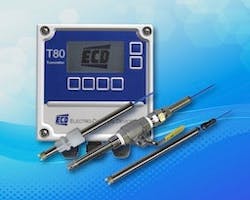Electro-Chemical Devices (ECD) now offers the Model T80 Universal Transmitter, a versatile, easy-to-use solution for virtually all liquid analytical measurements.
The ECD Model T80 Universal Transmitter is a single-channel transmitter designed for the continuous measurement of multiple parameters—pH, ORP, pIon, dissolved oxygen, turbidity, conductivity or resistivity—in a general-purpose industrial environment. The Model T80 digitally communicates with any ECD Model S80 Intelligent Sensor and automatically adapts the transmitter’s menus and display screens to the measured parameter. The Model T80 automatically configures to any of the listed measurements so that there is no need to inventory multiple instrument types, saving time and reducing operating costs.
The T80 Universal Transmitter it offers membrane switch navigation, a simple menu structure and soft key menu choices and an easy-to-read 2.75-by-1.5-in. LCD display. The T80 accepts any S80 intelligent sensor or any standard pH, ORP or pIon sensor with solution ground using the optional T80 input card. It is available with 4–20 mA output with MODBUS RTU on 24-VDC and 110/220-VAC instruments. The T80 can be configured with optional HART 7 communication and an optional three-alarm relay.
Source: Electro-Chemical Devices



